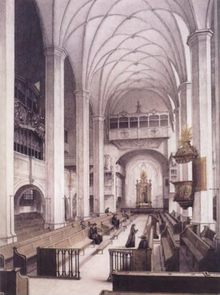St Mark Passion, BWV 247
|
St Mark Passion BWV 247 |
|
|---|---|
| Passion by J. S. Bach | |

Thomaskirche, Leipzig
|
|
| Related | based on BWV 198, BWV 248, BWV 54 |
| Occasion | Good Friday |
| Performed |
23 March 1731: Leipzig 3 April 1744: Leipzig |
| Cantata text | Picander |
| Comment | Music lost |
23 March 1731: Leipzig
The St Mark Passion (German: Markus-Passion), BWV 247, is a lost Passion setting by Johann Sebastian Bach, first performed in Leipzig on Good Friday, 23 March 1731 and again on Good Friday 1744 in a revised version. Though Bach's music is lost, the libretto by Picander is still extant, and from this, the work can to some degree be reconstructed.
Unlike Bach's earlier existing passions (St John Passion and St Matthew Passion), the Markus-Passion is probably a parody—it recycles previous works. The St Mark Passion seems to reuse virtually the whole of the Trauer Ode Laß, Fürstin, laß noch einen Strahl, BWV 198, along with the two arias from Widerstehe doch der Sünde, BWV 54. In addition, two choruses from the St Mark Passion were reused in the Christmas Oratorio. This leaves only a couple of missing arias, which are taken from other Bach works when reconstructions are attempted. However, since Bach's recitative is lost, most reconstructions use the recitatives composed for a Markus-Passion attributed to Reinhard Keiser, a work which Bach himself performed on at least two occasions, which gives a certain authenticity to things, although it could be viewed as somewhat disrespectful to Keiser's work. However, Keiser's setting starts slightly later than Bach's, which requires a small amount of composition on the part of the reconstructor.
Bach's St. Mark Passion was first performed in Leipzig on Good Friday, 23 March 1731. Written under the pseudonym Picander, Christian Friedrich Henrici's libretto survives in a 1732 poetry collection. The Markus-Passion is a modest setting, adding to Mark chapters 14 and 15 only eight free verse arias and 16 hymn stanzas. The chorales assume greater weight owing to their higher proportional use: 16 of the 46 movements are chorales in the St Mark Passion, whereas only 13 of 68 numbers are chorales in the St Matthew Passion. Five of the Markus-Passion texts appear to match the 1727 Trauer Ode, other likely parodies include BWV 54 and BWV 120a. However, no musical material remains for the Gospel texts or turba choruses. Further, we have no knowledge of the keys and orchestration which Bach used. While the libretto specifies which chorale melodies were used, Bach's harmonizations remain uncertain.
...
Wikipedia
